By: Thorsten Overgaard. July 7, 2018.
Add to Flipboard Magazine.
I flew from Brussels to Washington, D.C. on a red-eye for the opportunity to photograph President Trump
I'm a big fan of presidential photography; photographing a president has always been on my bucket list, preferably as much behind the scenes as possible. One of my favorite books is “The Clinton Years” by White House photographer Robert McNeely, shot with a Leica, showing pictures from his presidency. But any photographer who has had special access to a president, I find it interesting reviewing what they made out of it.
One of my favorite photos by McNeely is the one of Russian President Boris Yeltsin and President Clinton alone in front of the fireplace in the Oval Office. Everybody had left the room, and they were now to speak one-on-one. McNeely stands his ground as the White House photographer, and President Boris Yeltsin looks annoyed as if to say, “Didn’t you get the memo? Bugger off”; McNeely looks at President Clinton, who gives a nod that means, “He stays”. (There’s a one-hour talk by Robert McNeely on YouTube).
You cannot photograph the moment others want to indulge in if you aren’t there. You as a photographer have to be prepared for the moments, and you must be prepared to work within the short windows of being allowed there until the moment somebody decides to throw you out. Ideally, the photographer is the last one to leave the room. Stay a fly on the wall and make something out of the seconds it takes until someone discovers you and decides to throw you out. (You can read my article, "Photographing Bill Blinton" about my five-day trip to the Faroe Islands to photograph President Bill Clinton – and how I eventually eneded up alone with the President in a cafe).
So that’s what I try to envision. The possibilities of being a fly on the wall, or perhaps even a welcomed guest, in the moments where nobody else is there to see what happens.
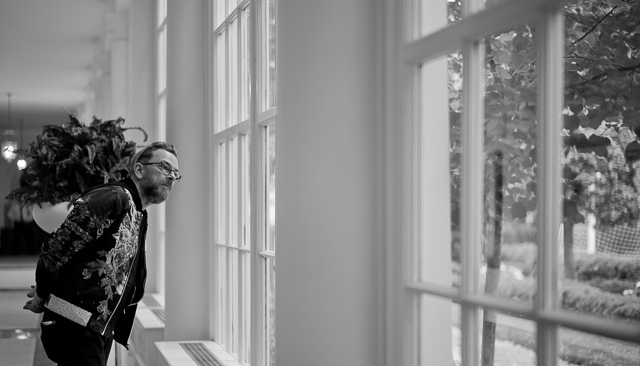
Thorsten Overgaard visiting the East Wing of The White House. Here having a look out to the West Terrace and the Rose Garden. Leica M10 with Leica 50mm Summilux-M ASPH f/1.4.
My morning in Washington, D.C. started with a tour of the White House East Wing, which was more of the normal tourist route than I had hoped it to be. Frankly, it was a tourist trap where I ended up having to photograph people with their own iPhones. I didn't know, back in Brussels I had gotten the impression it was to be a private tour. Instead it was a waiting line outside to go through security and into the West Wing. My visit as a guest to the White House Christmas Dinner half a year previously had been much more fruitful, with unlimited access to the whole place.
In the afternoon before the evenings event, I went to the event space to get an overview of the location, the backstage, and the schedule of who would arrive when, and where they would likely walk to the stage. I built a mental timeline and a map of possible locations I should try to be in to get my fly-on-the-wall photo.
As you know if you have read up on me, I flew to the Faroe Islands to photograph President Bill Clinton and had a one-on-one coffee-drinking photo opportunity with him in the midst of all the frenzy of the official visit. I was there, alone with Clinton – until someone decided to throw me out a few seconds later. I know the drill.
I am always looking and hoping for the unexpected – but not unlikely – moment of getting a chance to photograph the president off-guard and casually.
Which camera to use?
Part of my considerations for the President Trump photo was also which camera to wear. I decided upon the Leica M10 with the 75mm Noctilux-M ASPH f/1.25, knowing that this new, exciting lens might look so big it could cause problems at the entrance. I had a plan B but didn’t need it. It was a gala dinner, and thus not very restrictive on “professional cameras,” which usually means cameras with big lenses and/or flashes (and always remove the electronic viewfinder if you intend to use it, as it is often mistaken for a flash).

Tables decorated with chocolate treats courtesy of the president. Leica M10 with Leica 75mm Noctilux-M ASPH f/1.25. © Thorsten von Overgaard.
It's just a camera
I was seated at a table just next to the stage and I had scouted which locations I would photograph from beforehand. I tested the grounds before people got seated to see how the Secret Service would react.
Suddenly, a Secret Service woman walks determinedly over to me as I am next to the stage and the speaker’s chair. My eyes go to the bulge of weaponry beneath her jacket, and my heart freezes for a second. She stares at me and stops. “Are those Christian Louboutin sneakers?” she asks and points at my shoes. “Yes,” I answer, relieved. She nods approvingly and continues her rounds, remarking, “I love them.”
So far, so good. I’m recognizable; they’ve seen where I am and what I am doing. If the locations would cause a problem later, they would have told me by now. Of course, somebody else might come around later, with the President, who may see things differently.
You just have to limit your possibilities of sticking out. Only do what’s necessary. It’s like photographing in a museum. You plan the angles and things that you want, and when you have planned it properly and the scene is as you want it, you take the photo. The museum guard comes over and tells you, “No photographs,” and you act surprised and say, “Oh, I’m sorry.” You got your photo of children and people studying a painting. Then you walk to the next room in the museum where it’s a new guard and a new opportunity.
There are plenty of people who prefer that nobody takes any photos of anybody or anything, so you as a photographer must be able to decide what’s fair and what’s worthwhile to preserve; and find a way to do it without setting off all the alarms. As long as what you are making of it is valuable for history and a greater good, you can do it. I’ll get into that in another article, “Why No Photographs.”
Pre-vision of the photo: I got the photo, now I just need to take it
I know by now that President Trump will arrive just a few minutes before he goes on stage, and I know I won’t be allowed backstage. It is unlikely that I would have any plausible reason to casually hang around there. I already saw the tall Secret Service agent guarding the entrance, and while friendly and professional in his asking for credentials, the attitude was clearly that there would be no way they would let anyone in who just wanted to wander about and get a good photo!
I already have my location for the photo, which happens to be my seat at the dinner, next to the speaker’s chair. The saying is that President Trump is supposed to speak for 20 minutes, but he always speaks twice as long. All I have to do is sit and study the gestures and expressions and make a decision on which ones I want. Then get into action.
I'm not going to photograph non-stop for 20 or 40 minutes. I have certain looks I want, and overall they should communicate something about the person that gives you an idea about how and who he is. It’s like making a portrait of a person, but one who is speaking, and it won’t work with mid-sentence photos, open mouth, and so on. It has to be a moment of a pose in between all of the other things going on.
A determined look into the camera while not speaking. Maybe a smile.
There are already many photos of Trump with what I would call less desirable expressions. As a photographer you can make a person look undesireable if you want. A photo never lies, but the timing of the expression is in the hands of the photographer, and I only photograph people to make them look good. It says a lot about a photographer who lets bad photos slip out of his subjects. In fact, it speaks more about the photographer than the subject.
I work my location from the seat, the same location standing, from the front of the speaker's chair, from an angle amongst the tables, and from an angle behind the stage.
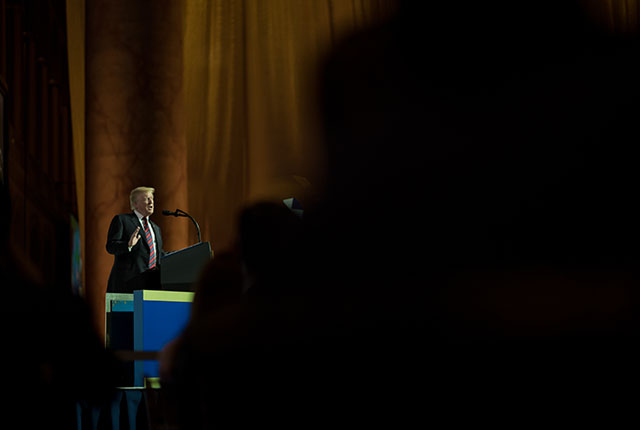
One of my planned angles from a location amongst the tables further back. President Donald Trump speaking. Leica M10 with Leica 75mm Noctilux-M ASPH f/1.25. © Thorsten von Overgaard.
How is President Trump up and close?
People ask, “How is he?” and the answer from a photographer’s and bystander's viewpoint as to how he is as s subject and a human, is that he is very energetic. He balances his weight from one leg to the other behind the speaker’s chair, like a Muhammad Ali dance, and he’s comfortable speaking, addressing specific people in the audience as if it were a family dinner rather than an official speech.
There are lots of expressions I don’t want to capture. Open mouth, freezing face, and you can tell he doesn’t really care to look photogenic for the cameras. His main aim is to affect the people he is speaking to, as if there were no press and no cameras. At this event, there happened to be 15-20 photographers below the speaker’s chair, herded in minutes before President Trump arrived.
It’s not easy to make a great, historically significant photograph of a speaker who uses gestures and talks most of the time. President Trump is not making it easier. From a live standpoint, he’s moving like he’s an athletic person in his 40s, and he is charming and confident, giving the impression that this speaking engagement is all he has on his program this week. In reality, he likely had a presidential schedule of meetings and work stretching 14 hours back before he got here. From a visual standpoint, he doesn’t have a slim face, and he doesn’t dress as slim as he could. He has a number of gestures and facial expressions that I could capture in-between sentences, which wouldn’t work for a photograph portraying the personality.
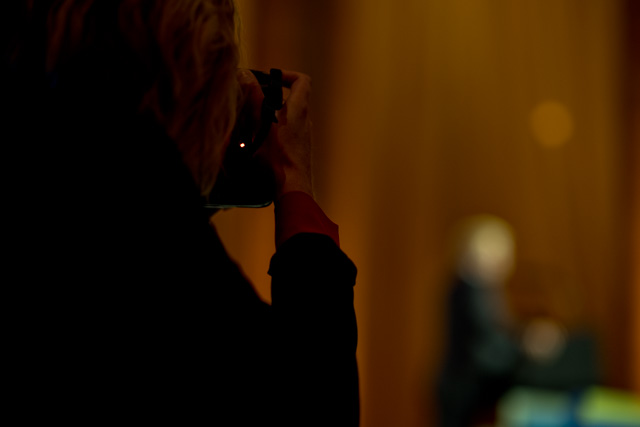
When the official White House photographer stands next to you, you know you got a good angle. Leica M10 with Leica 75mm Noctilux-M ASPH f/1.25. © Thorsten von Overgaard.
The more you photograph, the less you look. So I make it a point studying how it works visually, and then aim for the moments that could work. My total of photographs is 120 photos of President Trump and audience reactions during the 40 minutes, so I spend a lot of time observing, not photographing.
What I had been waiting for: A lucky strike
The photo I took away from the event is very cool, I think. It was what I wanted, a timeless photograph of President Donald Trump that somehow sums up his person and the era. I always look for the personality of a person, not their job nor their image. And I also look for a likeness to the person as they would like to see themselves, and as their family and friends would like to remember them. In my book, "The Portrait Book - How to Make People Look Beautiful", I talk about ‘capturing the soul,’ and by that, I mean the personality despite his current occupation and how they dress, their houses and cars. If you look at the photo and imagine it is the local football trainer who train the kids in the local football club, would the photo show him as a person? I think so. There happens to be more to the story, and to the degree you know the person, or you have formed your own opinions, that is what you as the viewer contribute to the portrait of the basic personality.

President Donald Trump at the Susan B. Anthony List Gala. Leica M10 with Leica 75mm Noctilux-M ASPH f/1.25. © Thorsten von Overgaard.
When we look back in 20 years, what person was he? That’s the photograph I would like to make.
So, I’m stealing that moment, and what I got was Trump looking straight at the viewer of the picture and smiling confidently.
Interestingly enough, this was very close to what I wanted, and I think that if one pre-visualizes the look, or perhaps more applicably, the significance and soul of the photo, one can recognize when the possibility arises and get it. If you have no idea, it’s going to be chance only, and likely what you will get will be a person behind a microphone.
| |
|
|
|
|
| |
Buy this New eBook by Thorsten Overgaard
|
|
| |
|
|
|
|
| |
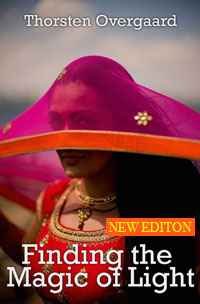 |
|
In this easy to read and apply eBook, Thorsten Overgaard takes you on a journey to see, understand and simply use light.
"One of the most important ways to get an aesthetic and pleasant picture is to find the good light."
"Finding the Magic of Light"
eBook for computer and iPad
Only $47.


Order now - Instant delivery.
44 Pages. More info. |
|
| |
|
|
|
|
I mave have hoped for some audience interaction, maybe President Trump walking out in the room, or something else giving other photo opportunities, but none of that happened. He came, talked and left. That’s where the family dinner feeling leaves and the reality of the presidential schedule and security steps in. He exits through the back of the stage and goes straight back to the White House.
I saw that at the Christmas Dinner as well; there’s no mingling with people or taking selfies and shaking hands for half an hour.
I had a tour of the White House later that evening again, this time the West Wing. For me, of course, it was another possibility of eventually bumping into President Trump. But the West Wing was empty of people, just a few working, and the Oval Office was open to look at but empty of action.
One interesting thing I got to see was the walls throughout the West Wing with lots of framed 13” x 19” prints from the White House photographers. It’s an ever-changing gallery of their work, displaying recent events like the French President Emmanuel Macron’s visit, and many other unique moments.
What was particularly interesting to me was the excellent quality of editing and printing. I was somewhat disappointed in a lot of the Obama period photographs done on mostly Canon DSLRs, and when President Trump took office, there wasn’t a White House photographer appointed until weeks later.
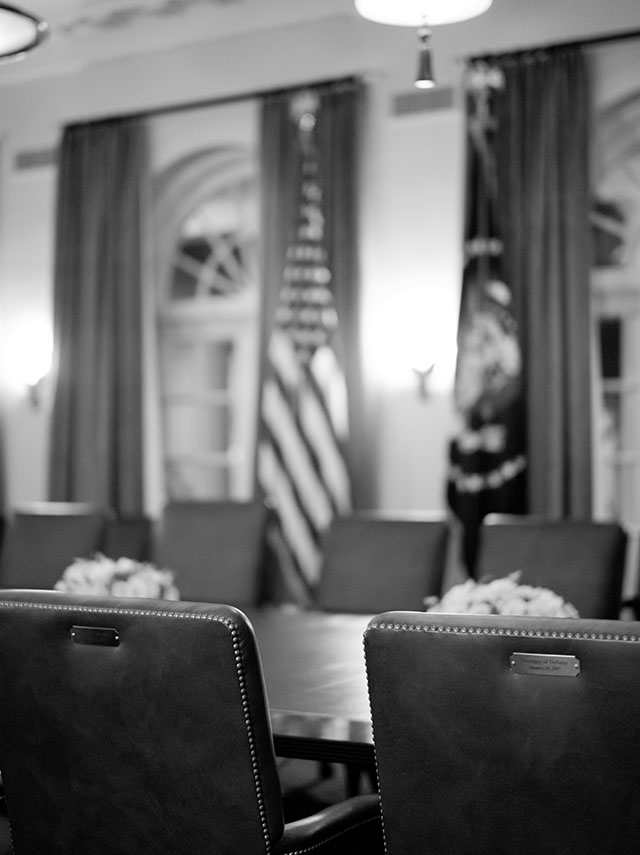
Evening at the Caibet Room of the White House West Wing. Leica M10 with Leica 50mm Summilux-M ASPH f/1.4.© Thorsten von Overgaard.
The White House officiel Flickr feed of White House photos of the time doesn’t do any justice compared with the many excellent and unique photos I saw on the walls there. I always feel a sort of desperation when history passes by and nobody makes any aesthetic preservation of it. So I was glad to see that my desperation was unnecessary. Like there eventually came a great photography book out of the Obama presidency by Pete Souza (who was a Leica Digilux 2 user for a while), there will be thousands and thousands of high-quality photographs from the Trump presidency.
As an aside, the photos on the walls have yellow Post-It notes on their backs, with the names of White House employees who would like to have the photos when they are taken down and new ones put up. A lottery draws the winner.
More to come ...
I hope you enjoyed today’s Story Behind That Picture. As always, feel free to e-mail me with suggestions, questions and ideas.
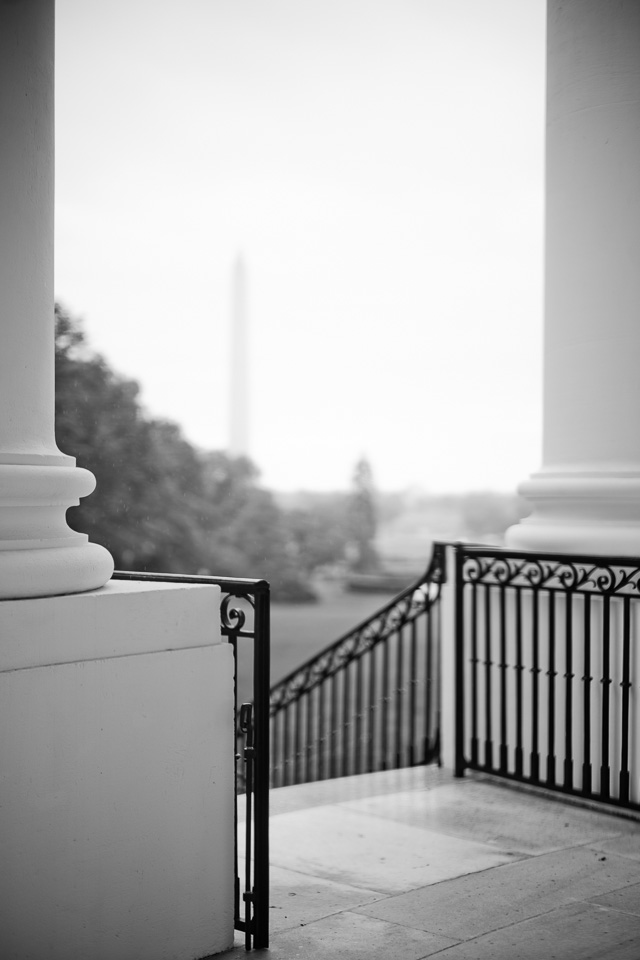 The Whie House view to the obelisk. Leica M10 with Leica 50mm Summilux-M ASPH f/1.4. © Thorsten Overgaard.
The Whie House view to the obelisk. Leica M10 with Leica 50mm Summilux-M ASPH f/1.4. © Thorsten Overgaard.
![]()
